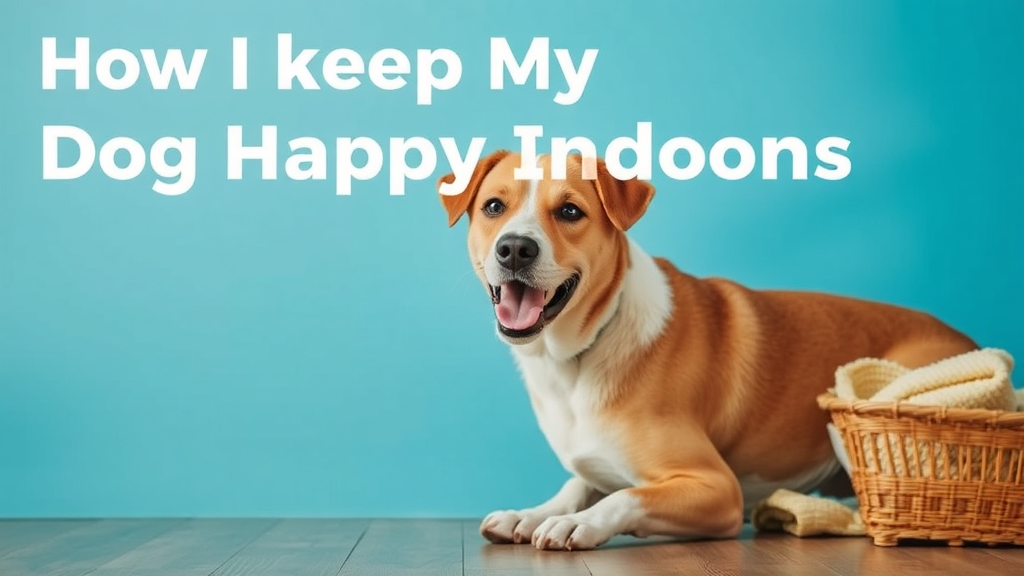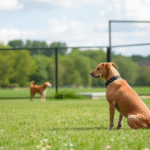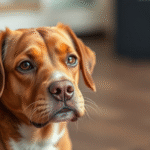How I Keep My Dog Happy Indoors
Keeping a dog happy indoors can be a fun and fulfilling challenge. Here are some tried-and-true methods that I use to ensure my furry friend is content even when we’re spending time inside.
Creating an enriching environment is crucial. Dogs thrive on stimulation, so I make it a point to have a variety of toys available. From chew toys to interactive puzzles, having different options keeps my dog engaged and happy. I frequently rotate the toys as well, which adds an element of surprise that can trigger my dog’s curiosity.
Daily Exercise
Even indoors, regular exercise is key to maintaining my dog’s happiness. While outdoor walks are vital, I also incorporate fun indoor activities that promote physical fitness. Here are a few ideas:
- Indoor Fetch: Use a soft ball to play fetch in a long hallway or spacious room.
- Stair Climbing: If you have stairs, running up and down can be a tiring workout for your dog.
- Hide and Seek: This game stimulates your dog’s mind and body. Hide somewhere in the house and call your dog to find you.
Engaging Activities
To keep my dog mentally stimulated, I include engaging activities in our daily routine. Dogs enjoy tasks that challenge their minds, so I often incorporate the following:
- Training Sessions: Learning new tricks or commands provides both mental stimulation and strengthens our bond.
- Puzzle Toys: Toys that require your dog to solve a problem for treats encourage critical thinking.
- Obstacle Courses: Set up a mini agility course using furniture or toys; guide your dog through it.
Social Interaction
Dogs are social animals, and I make sure my dog feels loved and secure indoors. Here are ways to enhance social interactions:
- Quality Time: Spend dedicated time petting, cuddling, or simply being near your dog.
- Playdates: Arrange playdates with other friendly dogs, if possible, to allow for socialization.
- Family Involvement: Encourage all family members to engage with the dog, allowing them to form strong bonds.
Comfortable Spaces
Creating a comfortable environment is essential for your dog’s happiness indoors. I’ve set up cozy resting spots throughout the house, which include:
- Soft Beds: Provide multiple beds or blankets in different rooms.
- Safe Zones: Create an area that is calm and quiet where your dog can retreat if feeling overwhelmed.
- Window Perches: Dogs enjoy watching the outside world, so consider a comfortable spot near a window.
Healthy Treats and Nutrition
What my dog eats plays a vital role in overall happiness and energy. I ensure that I provide a balanced diet with healthy treats. To keep things interesting, I incorporate various flavors, and sometimes, I even make homemade dog treats. This not only ensures that my dog enjoys tasty snacks but also keeps them engaged while cooking along with me.
Rotating Activities
To maintain my dog’s interest, I rotate activities and environments often. For instance:
- Change the locations of toys to renew excitement.
- Try new games or activities weekly.
- Vary the walks or the different spaces you let your dog explore at home.
Adopting new strategies and mixes helps keep our inside time fresh and exciting. By focusing on these aspects, I can be confident that my beloved companion feels loved and cared for, ensuring that my dog stays happy even indoors.
For more dog care tips or tips specifically targeting mental stimulation for dogs, you can visit the American Kennel Club or check out The Spruce Pets. These sites offer great resources to help every dog owner ensure their furry friend remains content and engaged.
The Importance of Playtime for Indoor Dogs
Keeping your furry friend entertained and mentally stimulated indoors is essential for their happiness and well-being. Playtime is vital for dogs and affects their behavior, health, and simply enjoying life. Here are several reasons why playtime is crucial for indoor dogs and strategies to ensure they’re getting the best experience possible.
Benefits of Playtime for Indoor Dogs
Engaging in regular playtime provides numerous benefits for your dog. Here are some key advantages:
- Mental Stimulation: Dogs require mental challenges just as much as physical activity. Playtime, whether with toys or interactive games, helps keep their minds sharp.
- Physical Exercise: Indoor play can be a great way for dogs to burn off energy, especially in limited spaces. It helps maintain a healthy weight and leads to overall better health.
- Bonding Time: Playing with your dog strengthens your bond. It fosters trust and reinforces their understanding of your cues and commands.
- Behavior Management: A well-exercised dog is often a well-behaved dog. Regular play can reduce destructive behaviors caused by boredom or excess energy.
- Emotional Well-Being: Playtime can alleviate anxiety and stress. It provides your dog with a sense of security and happiness.
Different Types of Indoor Play
There are myriad ways you can incorporate play into your dog’s daily routine. Here are some top suggestions:
- Interactive Toys: Invest in toys that require your dog to think. Puzzle toys, treat dispensers, or plush toys that squeak can keep them engaged for longer periods.
- Fetch: This classic game can be modified for indoors. Use soft balls or stuffed toys to prevent damage to your home while still allowing your dog to enjoy the chase.
- Tug-of-War: This energetic game is great for a workout. Just ensure to let your dog win occasionally, so they stay motivated and engaged.
- Hide and Seek: A fun way to enhance your dog’s problem-solving abilities. Hide treats or toys around the house and let your dog find them. It’s mentally stimulating and rewarding.
- Training Sessions: Make learning fun by turning training into a game. Use treats and praise to reward good behavior and instill new tricks.
Creating a Play-Friendly Indoor Environment
Setting up your home for playtime can enhance your dog’s experience. Here’s how to create an inviting space:
- Safe Area: Designate a specific area in your home for play. Ensure it’s free from breakable items and hazards.
- Variety of Toys: Rotate toys regularly to keep your dog interested and eager to play.
- Encourage Exploration: Use furniture or boxes to create obstacle courses that encourage active play and curiosity.
Time Management for Play
Finding the right time to play can make a significant difference in your dog’s activity levels. Make it a part of your daily routine. Here are some tips:
- Scheduled Playtime: Set aside specific times each day for interactive play. Consistency is key to establishing a routine your dog can rely on.
- Micro Sessions: Short bursts of play (10-15 minutes) can be just as effective as longer ones. This is particularly useful for busy schedules.
- Combine with Other Activities: Incorporate play into daily routines, like after meals or during breaks in your own work from home routine.
Regular indoor play is fundamental for maintaining your dog’s physical and mental well-being. Dogs thrive on interaction and engagement. If you want to delve deeper into the significance of play for dogs, check out resources from American Humane or explore further insights at American Kennel Club.
Remember, a happy dog makes for a happy owner! So, dedicate time to play and watch your indoor dog flourish with happiness and health.
Creating a Comfortable Indoor Space for Your Dog
Creating a cozy indoor environment for your dog can make a significant difference in their happiness and well-being. A comfortable space supports their need for rest, play, and social interaction. Here are some essential tips to help you create the perfect indoor setting for your furry friend.
Choose the Right Location
Finding the best spot for your dog’s space is crucial. Look for areas that are:
- Quiet: Avoid high-traffic areas where loud noises can disturb your dog.
- Well-lit: Natural light helps improve mood, so place your dog’s area near windows if possible.
- Comfortable: Ensure the space is free from drafts and temperature changes to keep your pet feeling safe and snug.
Comfortable Bedding
The right bedding is key to a happy indoor experience for your dog. You want to invest in a high-quality dog bed that provides:
- Support: Look for beds that cushion your dog’s joints, especially for older dogs.
- Washability: Choose beds with removable covers that are machine washable for easy cleaning.
- Size: Make sure the bed is appropriately sized for your dog, allowing them to stretch and move comfortably.
Engaging Toys and Activities
Keeping your dog mentally and physically stimulated indoors is essential. Here are some engaging toys and activities to consider:
- Interactive Toys: Invest in puzzle toys that can challenge your dog and provide rewards as they work to solve them.
- Chew Toys: Durable chew toys can help satisfy your dog’s instinct to gnaw while preventing boredom.
- Obstacle Courses: Set up a simple indoor agility course using household items to promote exercise and fun.
Regular Exercise
Even if your dog spends most of the time indoors, regular exercise is essential for their health and happiness. Consider these activities:
- Indoor Fetch: Use a soft ball or toy to engage in a game of fetch in a safe space.
- Tug-of-War: This fun game helps tire your dog out and can be played with a favorite rope or toy.
- Training Sessions: Spend time teaching your dog new tricks or commands. It stimulates their mind and strengthens your bond.
Safe Exploration and Relaxation
Creating a safe environment for your dog is non-negotiable. Here are some ideas to ensure they can explore and relax safely:
- Baby Gates: Use gates to restrict access to certain areas in your home.
- Tidy Spaces: Regularly remove hazardous items from your dog’s reach, including small objects they could swallow.
- Cozy Spots: Provide a few designated comfortable areas where your dog can rest and feel secure. A crate can serve as a private retreat.
Social Interaction
Dogs are social animals and need interaction with both humans and other pets. Ensure you spend quality time together:
- Playtime: Dedicate time each day to play with your dog and ensure they feel loved and connected.
- Training: Engage in regular training sessions; this not only teaches them new skills but also enhances your relationship.
- Paw-Some Friends: If your dog is social, consider inviting other dogs over for playdates.
By following these tips, you can create a comfortable indoor space that supports your dog’s needs and keeps them happy. For more ideas, check out The American Kennel Club for expert insights on pet care.
Additionally, consider resources like PetMD for more guidance on creating a welcoming home for your canine companion. Your furry friend will appreciate the effort you put into providing them with a comfortable indoor space.
Engaging Indoor Activities to Stimulate Your Dog’s Mind
Keeping your dog engaged and happy indoors doesn’t have to be a challenge. With a variety of stimulating activities, you can turn your living space into a playground for your furry friend. Here are some enjoyable ways to keep your dog entertained while making sure their mind stays sharp.
Interactive Toys
One of the best ways to stimulate your dog’s mind is through interactive toys. These toys are designed to be challenging and engaging, providing both mental and physical stimulation. Here are some popular options:
- Puzzle Toys: Toys like the KONG Wobbler or Outward Hound Hide-A-Squirrel can keep your dog busy as they work to retrieve hidden treats.
- Treat Dispensing Balls: These require your dog to roll a ball around to get treats to fall out, offering a fun way to stay active while thinking strategically.
- Snuffle Mats: These mats simulate foraging. Hide kibble amongst the fabric strips and let your dog use their nose to seek it out.
Training Games
Training doesn’t have to be boring! You can turn learning into a game. Here are some ideas:
- Hide and Seek: Have your dog sit and stay while you hide somewhere in the home. Call them to come find you. Not only does this teach them commands, but it also stimulates their hunting instinct.
- Find the Treat: Hide treats around the house and encourage your dog to use their nose to find them. Start easy and gradually increase the difficulty as your dog gets better.
- Clicker Training: Use a clicker to mark desired behaviors and reward them with treats. This can help sharpen their learning abilities and keep their minds engaged.
Physical Activities
Physical engagement is equally important in keeping your dog’s mind sharp. Here are some fun indoor exercises:
- Indoor Fetch: If you have enough space, throw a soft toy down a hallway for your dog to chase. Ensure the area is free of obstacles for safety.
- Obstacle Course: Set up a small obstacle course using cushions, chairs, and tunnels. Encourage your dog to navigate through it for a fun physical challenge.
- Stair Climbing: If you have stairs, gently encourage your dog to follow you up and down. It’s a great way to get them moving and burn energy!
Scent Work
Dogs have an incredible sense of smell, and you can engage this by playing scent games. Here are some fun activities:
- Scent Trails: Create a scent trail by dragging a treat along the ground leading to a hidden reward.
- Object Discrimination: Teach your dog to identify different objects by name. Use treats to reward them when they bring the right item.
Creative Activities
Tap into your dog’s creative side with some fun projects:
- DIY Toys: Use old t-shirts or towels to create tug toys. This not only provides enrichment but also encourages bonding.
- Doggy Art: Let your dog paint! Use non-toxic, washable paint and a canvas. Put paw prints on the canvas for a delightful piece of art.
- Cooking Together: Prepare homemade dog treats with your dog “helping” by sampling ingredients. This also teaches them patience!
Keeping your dog happy indoors doesn’t have to be a drain on your creativity or energy. With these engaging activities, you can stimulate your dog’s mind and build a deeper bond. To explore more ideas and creative activities, consider checking out sites like The Bark or Dogster.
Remember, the key is to be consistent and patient. Each dog is unique, so try out different activities to discover what your furry friend loves the most!
Training Techniques to Enhance Indoor Happiness
Keeping your dog happy indoors is all about engaging their minds and making sure they feel comfortable in their environment. Training techniques play a crucial role in enhancing indoor happiness. Implementing strategies that stimulate your dog’s intelligence and satisfy their natural instincts can create a joyful atmosphere. Here are some effective training techniques that you can use:
Positive Reinforcement
Positive reinforcement is one of the most effective training techniques. This method involves rewarding your dog for displaying desired behaviors. Rewards can include treats, praise, or playtime. When your dog associates good behavior with positive outcomes, they are more likely to repeat those behaviors. Here are a few example behaviors to reinforce:
- Sitting on command
- Staying in one place
- Not jumping on visitors
To get the best results, be consistent with your timing and types of rewards. For instance, immediately praise your dog after they sit when you ask them to.
Interactive Playtime
Enhancing indoor happiness can also be achieved through interactive play. Engaging activities lead to a physically and mentally stimulated dog. Consider games such as:
- Hide and Seek: Teach your dog to stay while you hide, then call them to find you.
- Tug-of-War: Use a strong toy to play tug, which can help release pent-up energy.
- Puzzle Toys: Introduce toys that require your dog to solve puzzles to receive treats.
These games not only promote exercise but also strengthen your bond with your furry friend. Make sure to vary the activities so that they remain exciting.
Teaching Tricks
Teaching your dog new tricks is a great way to keep them entertained and mentally stimulated. Simple tricks like rolling over, playing dead, or shaking paws can be fun for both you and your dog. Start with basic commands like “sit” and “stay” and gradually build to more complex skills. The key is to keep training sessions short, around 5 to 10 minutes, to maintain your dog’s interest.
Establish a Routine
Dogs thrive on routine. Establishing a daily schedule helps your dog feel secure and happy. A solid routine might include:
- Regular feeding times
- Scheduled potty breaks
- Dedicated exercise time
Having predictable activities helps reduce anxiety in dogs, making them more relaxed indoors. Make sure that you incorporate quiet time as well, providing a designated area where your dog can rest comfortably.
Socialization
Indoor socialization is just as important as outdoor socialization. Introducing your dog to various sounds, sights, and human interactions can help them adapt to living indoors. Arrange playdates with other dogs or invite friends over so your dog can interact with new people. You could also play recordings of different sounds like doorbells or vacuum cleaners to help them become accustomed to everyday noises.
Use of Crates
A crate can be an excellent tool for training and providing a safe haven for your dog. It can be a place where your dog feels secure. Make the crate inviting by adding soft bedding and toys. Incorporate crate training into your routine by:
- Gradually introducing your dog to the crate
- Using treats to encourage your dog to enter the crate voluntarily
- Avoiding using the crate as a punishment
This way, your dog will associate the crate with positive experiences, enhancing their comfort indoors.
Regular Exercise
Even when indoors, your dog needs regular physical activity. Engage in short play sessions throughout the day to release excess energy. Additionally, consider utilizing indoor equipment, like treadmills for dogs, to ensure they get their daily exercise even on rainy days.
Remember that a physically satisfied dog is often a happy dog. You can promote indoor happiness through consistent efforts in training, playtime, and the right routines. When your dog is mentally stimulated and physically exercised, they will thrive in your home.
For further reading and resources, check out the AKC’s training advice or visit PawPrint’s pet care tips.
Socializing Your Dog in an Indoor Environment
Socializing your dog in an indoor environment is crucial for their overall well-being. It helps create a well-adjusted pet who feels comfortable around various people and situations. Here are some effective ways to ensure your furry friend enjoys their indoor socialization experience.
Understanding the Importance of Socialization
Socialization is not just about introducing your dog to new people. It’s a holistic approach that encompasses exposure to different sounds, sights, and activities that you might encounter indoors. This can help reduce anxiety, build confidence, and ensure your dog is less likely to exhibit fear-based behaviors. Here’s how you can do it effectively:
Steps to Socialize Your Dog Indoors
Implementing a structured plan can make indoor socialization fun and enriching for your dog. Follow these steps:
- Create a Secure Environment: Ensure that your indoor space is safe. Remove any items that could harm your dog during their explorations. This includes small objects they can chew on or swallow.
- Introduce New Experiences Gradually: Start with sounds like the vacuum cleaner or construction noise from outside. Play these sounds at a low volume and gradually increase as your dog becomes more comfortable.
- Host Playdates: Invite friends and their pets over. Make sure the dogs are well-matched in energy and playfulness to prevent overwhelming your dog. This also encourages them to engage socially in a controlled environment.
- Use Treats for Positive Reinforcement: Every time your dog engages positively with a new experience or guest, reward them with treats. This helps them associate these experiences with good feelings.
- Incorporate Toys and Games: Bring out interactive toys that require puzzle-solving. Hide treats within these toys and allow your dog to figure out how to access them. It promotes mental stimulation and builds independence.
Activities for Indoor Socialization
Several activities can effectively enhance your dog’s social skills inside your home:
- Training Sessions: Engage in short training sessions that involve commands and tricks. Use distractions, such as sounds or movements of family members, to help your dog learn to focus amidst different stimuli.
- Obstacle Courses: Create a mini indoor obstacle course using furniture or toys. Encourage your dog to navigate through the course, introducing new obstacles regularly to keep their interest piqued.
- Interactive Games: Games like “Find the Treat” or “Hide and Seek” foster interaction between family members and your dog, encouraging them to focus on both human and environmental cues.
- Utilize Mirrors: If you have mirrors, let your dog explore their own reflection. This can be interesting and stimulate curiosity. Just monitor their reaction; some dogs may be startled.
Tips for Effective Indoor Socialization
For the best results, keep these additional tips in mind:
- Patience is Key: Don’t rush the process. Every dog has a unique pace at which they adapt to new experiences.
- Observe Body Language: Always pay attention to your dog’s reaction. If they seem anxious or uncomfortable, take a step back and allow them to acclimatize.
- Consistency Matters: Incorporate social activities into your daily routine. Regular exposure helps solidify your dog’s social skills.
- Consult a Professional: If you’re struggling, consider consulting a dog trainer or behaviorist for additional strategies. They can provide tailored advice specific to your dog’s needs.
To enhance your understanding of indoor socialization techniques, you can visit resources like American Kennel Club or PetMD which offer in-depth articles and advice on dog training and behavior.
In your journey of socializing your dog indoors, remember to keep the experiences positive and rewarding. By carefully introducing your dog to various environments and social settings, you will help foster a happy, well-socialized pet capable of navigating any situation with ease.
Nutrition Tips for Maintaining Indoor Dog Well-being
Nutritional choices play a significant role in keeping your indoor dog happy and healthy. Providing a balanced diet is the key to maintaining their overall well-being. Here are some essential tips to ensure your furry friend enjoys a nutritious lifestyle.
Understanding Your Dog’s Nutritional Needs
Each dog has unique dietary requirements based on their age, size, breed, and overall health. Generally, a mixture of proteins, carbohydrates, fats, vitamins, and minerals is crucial. Here’s a breakdown of these elements:
- Proteins: Necessary for building and repairing tissues. Look for high-quality meat, fish, or plant-based sources.
- Carbohydrates: Provide energy, especially for active dogs. Whole grains and vegetables are great options.
- Fats: Essential for skin and coat health. Fish oil and flaxseed oil can be beneficial.
- Vitamins and Minerals: Support various bodily functions. Include fruits and vegetables rich in these nutrients.
Quality vs. Quantity
When it comes to your dog’s diet, quality matters more than quantity. Choose high-quality commercial dog food that meets the AAFCO guidelines. Check the ingredient list; real meat should be the first ingredient. Avoid foods with fillers, artificial flavors, and preservatives.
Portion Control is Key
Overfeeding can lead to obesity, which is a common problem in indoor dogs. Follow the feeding guidelines based on your dog’s weight and activity level provided on the dog food packaging. Use a measuring cup to ensure you’re giving the right amount. Consider dividing their daily portion into two or three meals to help with digestion and prevent hunger-related anxiety.
Consider Special Dietary Needs
Older dogs or those with health issues may require specialized diets. Consult with your veterinarian to identify the best food for their condition. For example, dogs with allergies might benefit from a limited ingredient diet. On the other hand, dogs with joint issues often do better with food supplemented with glucosamine.
Hydration is Essential
Always provide fresh water for your dog. Hydration is crucial for their health, particularly with dry kibble diets. To encourage your dog to drink more:
- Change their water daily.
- Consider using a pet water fountain, which many dogs find more enticing.
- Offer wet dog food or add water to their kibble for added moisture.
Homemade Treats for Indoor Dogs
While store-bought treats are convenient, making homemade treats can be a fun way to bond with your dog while ensuring they are eating healthily. Here’s a simple recipe:
Peanut Butter and Pumpkin Dog Treats
- 1 cup pumpkin puree
- 1/2 cup peanut butter (ensure it’s xylitol-free)
- 2 cups whole wheat flour
- 1/4 cup rolled oats
- 1 egg
Mix the ingredients, roll the dough out, and cut it into shapes. Bake at 350°F for 20-25 minutes until golden. Let them cool before giving them to your dog.
Monitor Weight and Health
Regularly monitor your dog’s weight and overall health. If you notice any changes in their appetite or energy levels, consult your veterinarian. Keeping their health in check is vital for their happiness.
Stay Educated
Stay updated on the best nutritional practices by visiting reliable websites like WebMD for Pets or The Bark. These resources provide up-to-date information on dog nutrition and overall care.
Ultimately, every furry friend has unique needs. By staying informed and aware of your dog’s dietary requirements, you can create a nurturing indoor environment that promotes happy and healthy living. Remember, the love and care you provide through nutrition will contribute significantly to your dog’s well-being.
Key Takeaway:
Creating a happy environment for your dog indoors is essential for their well-being, especially when outdoor activities are limited. Here’s a key takeaway that synthesizes the various strategies covered in the article about keeping your dog happy indoors.
First and foremost, playtime is crucial for maintaining your dog’s mental and physical health. Engaging in regular play not only helps burn off excess energy but also strengthens the bond between you and your furry friend. Interactive games like fetch, tug-of-war, or puzzle toys can provide endless fun and stimulate your dog’s mind. Taking time every day to engage in play will help keep your dog active and content.
Moreover, it’s vital to create a comfortable indoor space tailored for your dog’s needs. This can involve providing a cozy bed, easy access to water, and designated areas for toys. A calm and welcoming environment will make your dog feel secure and relaxed, which is a key factor in their overall happiness.
In addition to physical comfort, incorporating engaging activities can significantly stimulate your dog’s mind. Simple things like hiding treats around the house or teaching new tricks can keep your dog’s brain active and prevent boredom. training sessions not only makes them feel productive but also reinforces good behavior.
Another essential element is socialization, even in indoor settings. Arranging playdates with other dogs or allowing your dog to interact with family members will keep them socially balanced. Dogs are social creatures, and regular interaction with other pets and humans will contribute positively to their mood.
Nutrition plays a pivotal role in your dog’s well-being. A balanced diet contributes not only to physical health but also influences mood and energy levels. Therefore, incorporating nutritious treats and meals that cater to your dog’s dietary needs is fundamental.
By focusing on playtime, comfort, mental stimulation, socialization, and nutrition, you can create a nurturing indoor environment that promotes happiness and well-being for your dog. Implementing these strategies will ensure that your dog thrives, even when spending time indoors.
Conclusion
Keeping your dog happy indoors is a fulfilling journey that combines love, care, and attention. As you engage in playtime, you’re not just having fun; you’re strengthening the bond between you and your pet. A comfortable and cozy indoor space can transform your dog’s daily experience, making them feel secure and content. With various engaging activities, you can challenge your dog mentally, enhancing their happiness and overall well-being.
Effective training techniques not only reinforces good behavior but also gives your furry friend a sense of purpose. Socializing your dog, even within the home, opens up opportunities for them to interact and learn, fostering a more adaptable temperament. Don’t overlook the importance of nutrition; a balanced diet plays a crucial role in your dog’s mood and energy levels.
By implementing these strategies, you create a joyful and stimulating indoor environment. Your dog will thrive, and in turn, you’ll enjoy a deeper, more satisfying companionship. Remember, a happy dog equals a happy home, and every moment spent caring for your dog indoors strengthens the unforgettable bond you share. The little things you do—play, train, feed, and socialize—can make a world of difference in your dog’s indoor happiness. Embrace this journey with love and creativity, and watch your dog flourish right within the comforts of home.







Leave a Reply